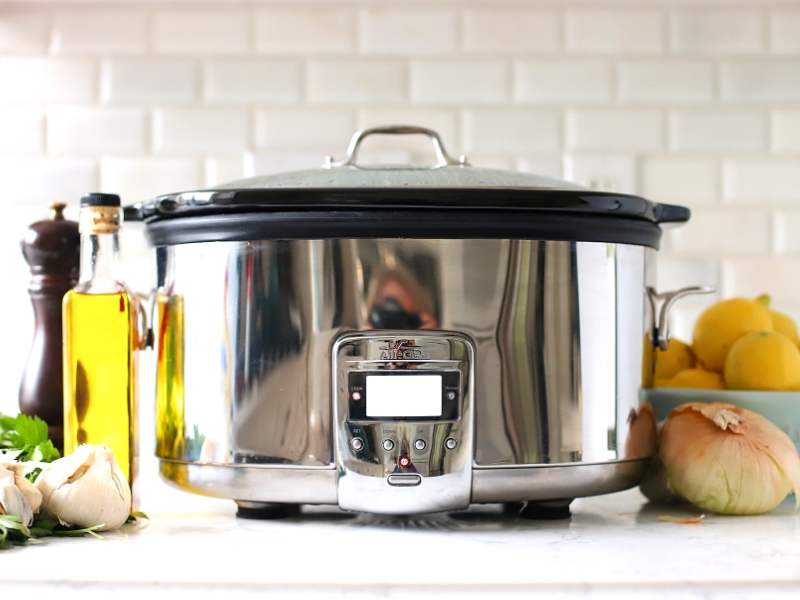Welcome to TheKitchenApplianceDad.com! Today, we’re diving into the world of slow-cooked goodness without the traditional appliance many assume is necessary – the slow cooker. Whether you’re lacking kitchen space for another gadget, your slow cooker met an untimely end, or you’re simply looking for alternative methods, worry not. Let’s explore how to achieve those tender, flavorful dishes that are synonymous with slow cooking, even without the actual slow cooker.
Understanding Slow Cooking
Before we dive into the alternatives, it’s essential to understand what slow cooking really entails. Slow cooking is a process where food is cooked at a low temperature for an extended period. This method is excellent for breaking down tough cuts of meat and for developing deep, complex flavors in dishes. It’s also incredibly convenient for those who prefer a “set it and forget it” approach to cooking.

Using Your Oven as a Slow Cooker
The Low-Temperature Method
One of the most straightforward methods to mimic a slow cooker is by using your oven. Here’s how to do it:
- Preheat your oven to a low setting. A temperature between 200°F (93°C) and 300°F (149°C) is ideal, depending on the recipe and the time you have available.
- Use a heavy, oven-safe pot. Dutch ovens with tight-fitting lids are perfect for this purpose. If you don’t have a Dutch oven, any heavy pot or casserole dish with a lid can work; just ensure it’s oven-safe.
- Prepare your recipe as usual, browning meat if necessary, and combine all ingredients in your pot.
- Cover and place in the oven. The lid will help trap moisture and heat, simulating the slow cooker environment.
- Cook for an extended period. This can range from 2-8 hours, depending on the recipe and oven temperature.
- Check occasionally. While not as hands-off as a slow cooker, it’s wise to check your dish every couple of hours to ensure it’s cooking evenly and not drying out.
Oven Bags as a Solution
Another method within your oven involves using oven bags. These special bags are designed to withstand low oven temperatures while locking in moisture, which can help prevent your food from drying out.
Stovetop Slow Cooking
Simmering on Low Heat
Your stovetop can also serve as an excellent slow cooker substitute. Here’s what you need to know:
- Use a heavy-bottomed pot or Dutch oven. This ensures even heat distribution and reduces the risk of burning.
- Bring your dish to a boil, then reduce the heat to the lowest setting.
- Cover with a lid, leaving it slightly ajar if necessary to prevent the liquid from boiling over.
- Maintain a gentle simmer. You want a few bubbles to surface occasionally – that’s how you know it’s at the right temperature.
- Stir occasionally, especially if your dish contains ingredients prone to sticking or burning.
Diffuser Plates for Even Heat
Using a diffuser plate can help distribute the heat more evenly on your stovetop, which is particularly useful for delicate dishes that require consistent low heat.
Slow Cooking with Electric Appliances
Using a Rice Cooker or Multi-Cooker
Some electric appliances, like rice cookers or multi-cookers, have slow cook settings that can be suitable substitutes.
- Use the slow cook setting if available. Follow the instructions specific to your appliance.
- If there’s no slow cook setting, use the lowest setting available and monitor the cooking process closely.
Repurposing Your Electric Pressure Cooker
Many electric pressure cookers also come with a slow cook function. If you own one, consult your manual to learn how to use this feature effectively.
Alternative Cooking Methods
Microwave Cooking
Though not ideal for every recipe, you can use a microwave for certain slow cooker recipes, particularly those with high liquid content like soups or stews.
- Use microwave-safe cookware with a lid.
- Cook on a low setting, stirring occasionally to ensure even cooking.
- Be cautious of hot spots and adjust the power level as needed.
Solar Oven Cooking
For the eco-conscious cook, a solar oven can be a fun and sustainable way to slow cook your food using the power of the sun.
- Set up your solar oven according to the manufacturer’s instructions.
- Cook times will vary greatly based on the weather and your geographic location.
Tips for Successful Slow Cooking Without a Slow Cooker
- Keep the lid on to trap heat and moisture.
- Adjust liquid amounts. Some methods may require more or less liquid than traditional slow cooker recipes.
- Cut food into uniform pieces to ensure even cooking.
— Experiment with timing. Cooking times can vary widely between methods, so be prepared to adjust as needed. - Season appropriately. Slow cooking develops flavors differently, so you may need to tweak your seasoning when using alternative methods.
Key Takeaways
Cooking slow cooker recipes without the actual appliance can be a creative and rewarding endeavor. Here’s a summary of the key points to remember:
- Understand the principles of slow cooking: Low heat and prolonged cooking time are the cornerstones of this method.
- Utilize your oven: Low oven temperatures and heavy pots can simulate the slow cooker environment.
- Explore stovetop techniques: A gentle simmer on a low heat with a heavy-bottomed pot can yield excellent results.
- Leverage other kitchen appliances: Rice cookers, multi-cookers, and electric pressure cookers may have settings that allow for slow cooking.
- Be mindful of adjustments: Liquid levels, cooking times, and seasonings may need to be modified depending on the method you choose.
Embracing these techniques will open up a world of culinary possibilities, ensuring that you never miss out on the comfort and convenience of slow-cooked meals, even without a slow cooker in your kitchen arsenal. Thanks for joining TheKitchenApplianceDad.com on this delicious journey, and happy cooking!


